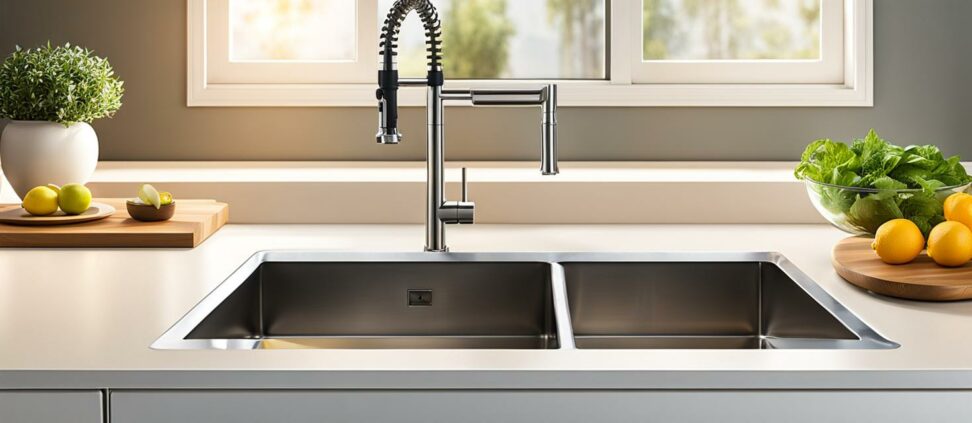Choose the Perfect Kitchen Sink Drain Pipe Size - Here's How
Is your kitchen sink draining slower than it used to? Do you find yourself plunging and snaking the drain multiple times per week? Choosing the wrong kitchen sink drain pipe size could be the culprit behind your clogged drains and drainage woes.
Getting your kitchen sink drain pipe size right is an important plumbing detail that prevents headaches down the road. Read on to learn how to choose the perfect kitchen sink drain size for optimal water flow and clog prevention.
Why Kitchen Sink Drain Pipe Size Matters
At first glance, drain pipe size seems insignificant. But it directly impacts how quickly water can flow from your sink to the main drain line. An undersized kitchen sink drain pipe leads to backups and clogs from food particles, grease, and soap scum buildup. Going too big with your kitchen sink drain diameter causes problems too - it can bottleneck at connections to smaller pipes underneath.
Matching your drain line size to the existing plumbing in your home is key for proper drainage. Avoiding leaks or water damage depends on getting kitchen sink drain pipe sizing right. Considerations like garbage disposals and heavy use make a difference as well. Understanding the factors that determine the ideal kitchen sink drain size will set your plumbing up for success.

Determining the Right Kitchen Sink Drain Pipe Size
When embarking on a kitchen remodel involving the sink, start by measuring the diameter of your existing drain pipes with a tape measure. Note where under the sink they connect to the main drain line. Inspect the condition of old pipes and connections while you're at it to identify potential problem areas.
The type of kitchen sink you choose will impact the drain size needed. A large double bowl sink or farmhouse style requires a larger diameter drain pipe than a modest single bowl model. Stainless steel and porcelain sinks should have a minimum 1 1/2 inch drain, but go larger if you'll be washing big pots and pans. Consider existing garbage disposals too - most need a 1 1/2 inch kitchen sink drain at minimum.
Common Kitchen Drain Pipe Sizes
While codes allow 3/4 inch and 1 1/4 inch kitchen sink drains, 1 1/2 inches is the standard residential size. It offers a good balance of clog resistance and water flow capacity for most kitchen sinks. If your existing drain lines are 1 1/4 inches, this is an easy swap.
A 2 inch kitchen sink drain pipe is overkill for regular home use but necessary for giant commercial sinks. On the other end, a 1 1/4 inch pipe makes sense for a mini prep or bar sink that won't see heavy use. Just know it clogs more easily.
How to Choose the Right Kitchen Sink Drain Pipe Size
Follow this process when selecting your kitchen sink drain pipe size:
- Calculate the required flow rate based on sink compartments and dishwasher connection if applicable.
- Choose a pipe size above the minimum flow rate needed.
- Ensure adequate diameter for garbage disposals per manufacturer specs.
- Match drain size to existing plumbing infrastructure.
- Factor in frequency of use (larger for heavily used sinks).
Err on the side of going slightly bigger with your kitchen sink drain diameter. This prevents bottlenecks and backups. Just don't go overboard to where you create connection issues. Adapters can transition between pipe sizes if needed.
Common Kitchen Sink Drain Components
Your kitchen sink drain assembly contains other important components besides the main drain pipe:
- Tailpiece - Short section that extends vertically to connect the sink to the drain.
- P-trap - Curved section that holds water to prevent sewer gas from entering.
- Adapters - Connect pipes of different sizes (slip joints, bushings, etc.).
A variety of drain baskets and strainers attach to the tailpiece as well. They catch food scraps before going down the pipes. It's smart to periodically remove and clean sink drain strainer baskets.
Choosing the optimal kitchen sink drain pipe size may not seem exciting, but it makes a big difference in how well your sink drains. Now that you know how to measure your existing drain line, calculate required flow rates, and select the right diameter, you can avoid problems from improper sizing.
Follow these tips for a kitchen sink drain that keeps water flowing freely for years to come. And remember to periodically clean out P-traps and drain baskets - preventing clogs is easier than removing them!